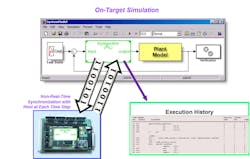LDRA integrates tool suite with MATLAB and Simulink, verifies model at object code level
WIRRAL, U.K., 5 April 2013.LDRA, a provider of standards compliance, automated software verification, source code analysis, and test tools, offers verification of the model via integration with MATLAB and Simulink.
To boost the quality and efficiency of safety-critical design, the LDRA tool suite now analyzes, instruments, and assesses code coverage of source and object code during the model phase of development.
The LDRA tool suite can now use real-world data from MATLAB that’s connected to a Simulink model to verify the application at source code and object code levels. Developers can fine-tune the model to reflect a data-driven flow of information, reducing the amount of error-prone manual manipulation necessary for the model-generated code to achieve DO-178C, Level A certification.
“Rigorous verification of the safety-critical systems found in avionics, defense, and high-speed rail has resulted in stellar safety records, but at a significant financial and time-to-market cost,” notes Ian Hennell, LDRA operations director. “Through this integration, LDRA gives companies a way to maintain best-of-breed software practices and quality while better managing the work flow, schedule, and cost of development.”
The most critical levels of certification require comprehensive testing of an application by independent analysis not only at the source code level, but also at the machine code assembler level, says a company spokesperson. While model-driven development typically ensures consistent code, verification previously required many more steps.
Developers could verify the model, but the code had to be extracted, instrumented, connected to an execution harness, and executed against functional verification data to ensure the model-generated code properly managed a real-world situation.
Discrepancies in the functionality required developers to rework the model and manually manipulate the code. Not until the developer could prove that every line of code had been fully tested could an application be submitted for Level A certification.
LDRA tool suite, now with integration with MATLAB and Simulink, enables users to run real-world code generated by Embedded Coder in software in the loop (SIL) and processor in the loop (PIL) simulations. The LDRA tool suite will analyze both the source and object codes entirely inside the same LDRA framework. LDRA acts as an independent verification layer, working within the MATLAB and Simulink environment.
By applying data from models, developers can better understand how various components of the application interact with each other. Defects in the design can be identified, and changes made to the model directly, eliminating many hours of error-prone iterations between the model, code and data.
“The integration of MATLAB and Simulink with the LDRA tool suite enables developers to reuse their requirements-based model simulation test framework now on the executable object code. This improves the efficiency and quality of code while continuing to meet the highest criteria of industry certification,” says MathWorks Embedded Applications Manager Tom Erkkinen.
Follow Avionics Intelligence news updates on Twitter (@Avionics_Intel), LinkedIn, and Google+.


